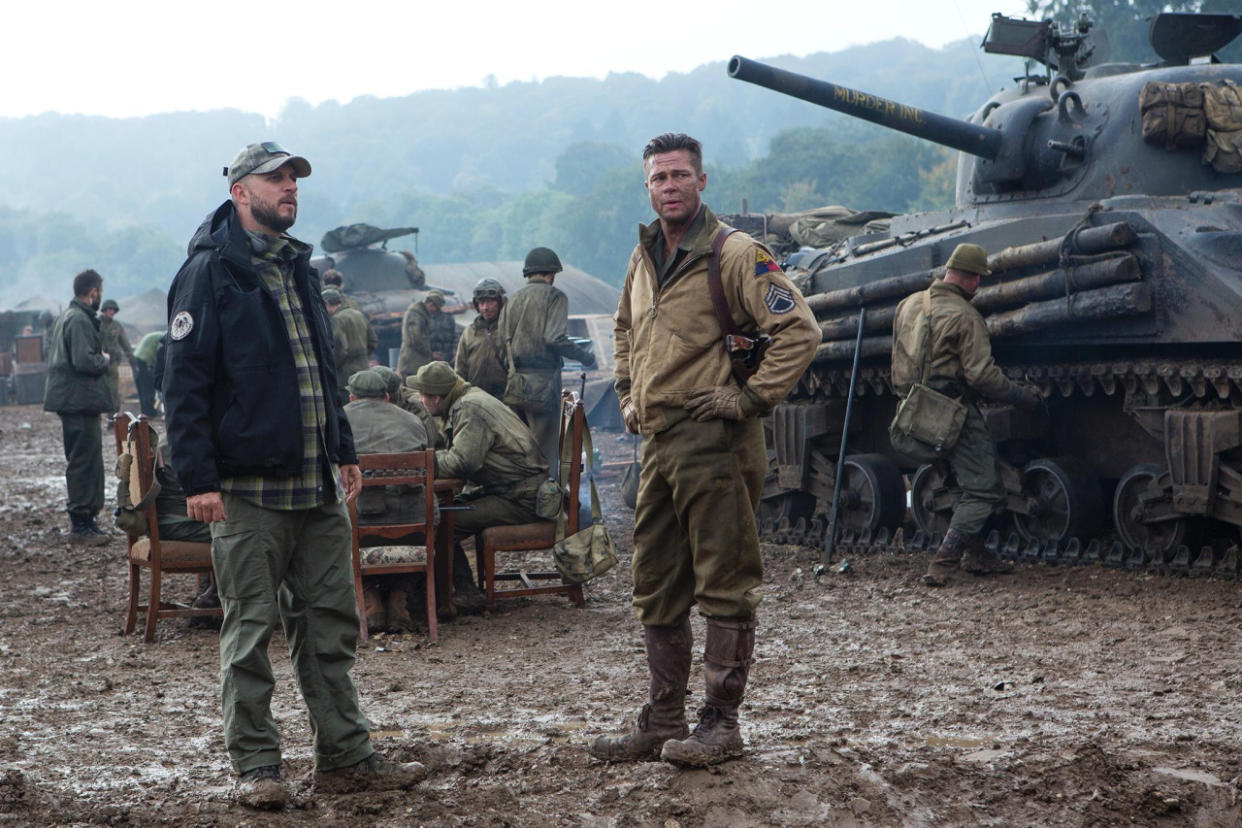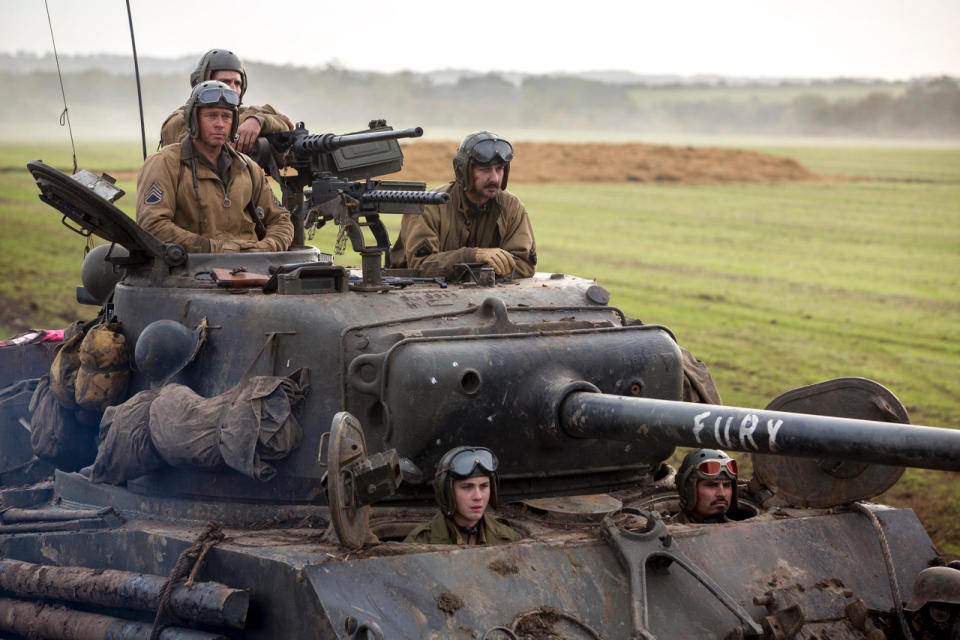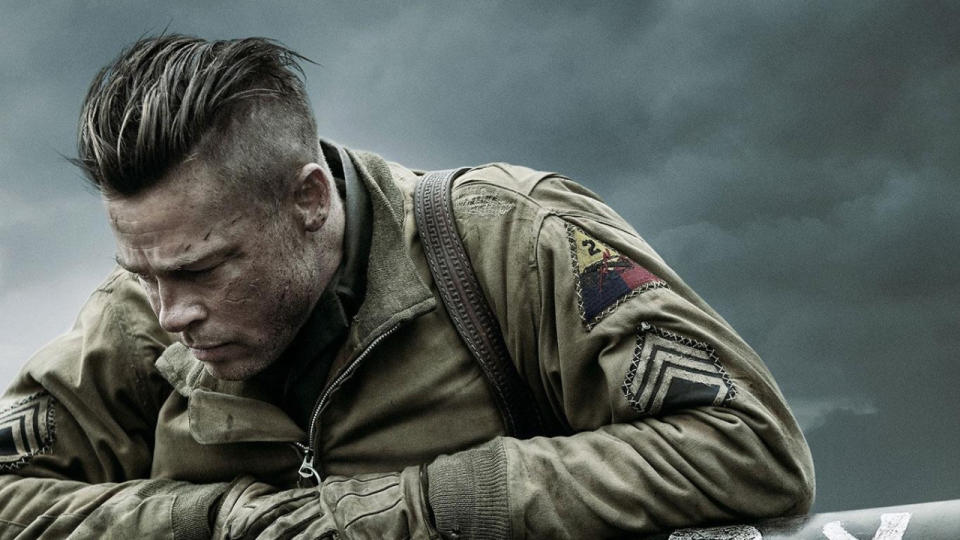'Fury' Director David Ayer on Working With Shia LaBeouf, Old-Fashioned Heroism, and All That Mud

Director David Ayer consults with Brad Pitt on the set of ‘Fury’
David Ayer, the writer-director known for frenetic movies about cops and soldiers, is a slightly worked up when I enter the office. He’s already got a semi-permanent scowl — the guy has seen things, having grown up in South Central LA and served in U.S. Navy — and now, he’s a bit pissed off at some of the negative reviews slamming his new WWII epic, Fury, which he says the offending critics just don’t understand.
“It doesn’t wear its politics on its sleeve. People are trying to decipher it. Plus, it’s kind of an old-school movie, so there’s not all these contemporary, angst-ridden, modern kind of characters,” he says. “I very much tried to base it in that time, and not project too much 21st-century complexity into it.”
I suggest that, in the era of Breaking Bad anti-heroes and morally ambiguous wars being waged in real life, critics and audiences have been conditioned to expect darkness and moral compromise from protagonists. Such traits he says he largely tried to keep out from his new film, which stars Brad Pitt as a tank commander who leads his crew (played by Shia LaBeouf, Michael Peña, Logan Lerman, and Jon Bernthal) into the heart of Germany in the war’s waning days.
“Everyone’s supposed to have father issues or be very very angst-ridden,” says the 46-year-old Ayer (who wrote 2001’s Training Day and directed 2012’s excellent cop drama End of Watch). “The men of that period were very dead-ahead kind of individuals, especially Brad’s character. He’s really playing guys like my grandfather, who weren’t conflicted. Or if they were, they never showed it.”
Which isn’t to say that the soldiers in Ayer’s relentlessly violent film are angels cloaked in stars and stripes. After years at war, they are half-savage, transformed by brutality and bloodshed into survivors clinging on to their humanity.
Ayer went deep with Yahoo Movies about making the film, working with LaBeouf and Pitt, and how we view modern warfare.

The ‘Fury’ cast includes (clockwise, from left): Pitt Jon Bernthal, Shia LaBeouf, Logan Lerman and Michael Pena
These guys were together for a while.
I had them for six-plus weeks. Shia started prep way early. He embedded with a National Guard unit, and shadowed a military chaplain. He did a lot of work and research on his own to get into the groove. But they all did. They become this family. They’re like brothers, uncontrollable, you need a cattle prod to shut them up. And you really feel that on screen.
Last December, I was the first person to notice that Shia’s short film had been plagiarized, so I wrote about it and broke the newsBut then I started feeling guilty after how seemingly crazy he went.
You’d have to ask him how orchestrated, or not, everything was. It was living performance art. At the end of the day, he’s this brilliant fucking actor. And I think he’s doing everything he can to kind of burn his past in the fireplace, really shed his skin as an actor. The dude is one of the best I worked with, he’s freaking unbelievable.
I know you used a lot of authentic tanks and weapons; how did the Fury tank, the one you filmed in, work?
It’s great shooting in the UK because the craftsmen over there are unbelievable. We built the tank interior, we took molds and used the blueprints in the tank as much as possible. And then we built slightly 10-percent over-scale interior, and mounted it on a gimbal. But everything functioned: the turret turned, the shells fed and ejected, the machines gun fired. So it did all the things that tanks are supposed to do. Then Roman did this unbelievable job of lighting it.
It’s like those old movies, where somebody is driving a car and you have that big light on their face: It just looks fake. We wanted to avoid that, so we had dozens and dozens of tiny lights attached to a digital controller. It was a brutal set, my soul would die every time I had to work on it, because it was so painstaking and tweaky. It sometimes took two hours to set up one camera shot.
Was the tank closed, with a camera inside, if it wasn’t an open, bisected set piece?
It was fully closed, and then we would pull panels off and then stick the camera through. Everything still worked. So the actors, who were all trained,and really understood their battle stations, could do everything they needed to do in that tank interior as combat crewmen.
There was so much mud in the film. I remember wondering, and making a note to ask, about your mud budget.
We were outside of London, which is beautiful, but there is a lot of mud. Every now and then, someone would just slip and go down and then they’re just [covered] head to toe. It’s like, good lord, sorry dude.
I got yelled at by production for ordering so many water bowsers to do wetdowns. This area is on chalk, and no matter how much water you pour on, in a couple of hours, it’s gone. It’s amazing drainage.
Did you ever have to get mud trucked in?
No, it was a farm. We did truck in some of the stuff, though. Organic matter — which was cow shit, to color the mud.

In WWII, people are being drafted into the military or enlist, a whole generation went to war. Now it’s all-volunteer. So do you think that changes the way we see the military, or make movies about it?
Absolutely. Back then you had a whole generation of men who went off to war. And they met all sorts of people, and got to see the world. They had all these experiences and experienced a lot of traumas, And then they came back, and built our world as we know it. That’s really what Norman’s character is about, raised by these four big brothers. The sequel would be him having a family, and starting a company, and going to college, and becoming a fucking gazillionaire.
Today, you have the small, all-volunteer force, that really is, in a lot of ways, outside regular society. If you want to see something that’s about the service, go see Restrepo. That tells you what it’s like to serve in the army. It’s a documentary that gets inside who these guys are and their relationships with each other. And that’s what I try to bring to the screen. It’s not about who they are, or their past, like I’m from this farm or my dad beat me up or whatever, it’s none of that modern psychoanalytic crap. It’s how they interact with each other, what their relationships are with each other. And that’s what this movie is, it studies a family. A family under duress, a family that happens to live in a tank and kill people.
How do you simulate that on film?
That was the hard part. A lot of sparring, a lot of rehearsal, a lot of training together. They learn these stations. We did the boot camp, which was run by a couple of Navy SEALs, and there really is a dark art to that, man. Breaking them up, just destroying the individual. And creating the group. And when that as over, you could look at them — their energy was so different and they were just so fucking close, I was jealous.
And Pit is 50 years old and doing it.
That fucker is in shape, it’s crazy.
You wrote the first Fast and Furious movie. They’re up to seven now.
Yeah, Jesus, fuck.
Have you seen any of the recent ones?
[A pause and a laugh]
Is it so wildly different than what you first envisioned?
I think they ran with the heist concept, but yeah, it’s pretty nuts. The success of that has been pretty nuts. The loss of Paul was pretty devastating, because he was a dude. He was a shockingly normal, cool guy.
So you have nothing to do with them now?
No, no. I did some work on one of them, a couple back.
It’s crazy to create something and then have Hollywood take control of it.
It’s pretty standard. You chase this success, you find out what elements work, and if you can crank them out, it’s a license to print money.
Want to see Fury? Visit our Showtimes page to get tickets.

